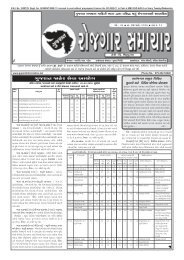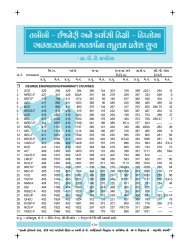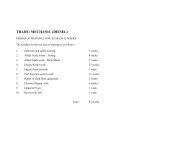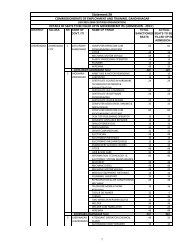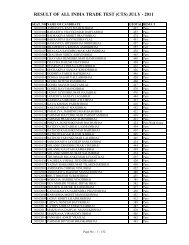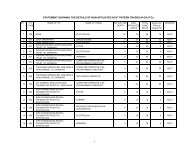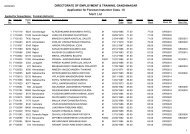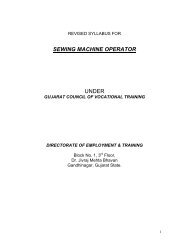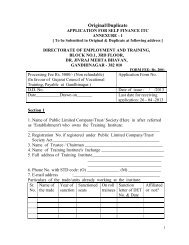General Information - Talim Rojgar
General Information - Talim Rojgar
General Information - Talim Rojgar
You also want an ePaper? Increase the reach of your titles
YUMPU automatically turns print PDFs into web optimized ePapers that Google loves.
<strong>General</strong> <strong>Information</strong><br />
1. Name of the Trade : Draughtsman (Mechanical)<br />
2. N.C.O. Code No. : 030.40<br />
3. Duration of Craftsmen<br />
Training : 2 years<br />
4. Duration of Apprenticeship<br />
Training : 3 years including 2 years of Basic Training.<br />
5. Entry Qualification : Passed 10 th class examination under 10 + 2<br />
System of education with science and math’s<br />
Or its equivalent.<br />
6. Rebate for ITI Trainees : 2 years in the same trade<br />
7. Ratio of Apprentice of<br />
Workers. 1: 10
SYLLABUS FOR THE TRADE OF DRAUGHTSMAN ( MECHANICAL)<br />
UNDER CRAFTSMEN TRAINING SCHEME<br />
WEEK<br />
NO.<br />
Practical Trade Theory W/shop Calculation<br />
and Science<br />
1. Induction Training<br />
Familiarization with the<br />
Institute Importance of trade<br />
training, machinery used in<br />
the trade, type of work done<br />
buy the trainees in the instate<br />
types of jobs made by the<br />
trainees in the trade<br />
introduction to safety<br />
including fire fighting<br />
equipment and their uses etc.<br />
2. Practice in using instrument.<br />
Drawing of straight and<br />
curved lines, Drawing angles,<br />
circles etc.<br />
03. Letters, Block letters, Italics<br />
etc. and numerals.<br />
Importance of safety<br />
and general<br />
precautions observed<br />
in the instt. . And in<br />
the sections.<br />
Importance of trade in<br />
the development of<br />
industrial cola of the<br />
country. Related<br />
instruction. Subject to<br />
be taught achieve<br />
dement to be made.<br />
Recreational ,<br />
medical facilitates<br />
and other extra<br />
curricular activities of<br />
the Instt. (All<br />
necessary guidance to<br />
be proved to the new<br />
comers to become<br />
familiar with<br />
working of Industrial<br />
Training Institute.<br />
System including<br />
stores procedure etc.<br />
Nomenclature and use<br />
of drawing<br />
instruments & various<br />
equipment in drawing<br />
office. their care and<br />
maintenance. Lay out<br />
of a drawing sheet.<br />
Type of lettering<br />
proportion and<br />
spacing of letters and<br />
words.<br />
British MKS and SI<br />
units-their conversion.<br />
More emphasis on<br />
MKS & SI units.<br />
Units of length and<br />
relation between them.<br />
Deduction of<br />
corresponding units of<br />
area and volumes.
04. Plane geometrical<br />
construction triangles,<br />
polygons, circles.<br />
05 construction of ellipse<br />
parabola & hyperbola,<br />
construction of involutes,<br />
cycloid curves, helix and<br />
spiral.<br />
06 projection of points and<br />
lines. projection of plane<br />
figures.<br />
07 Projection of solids prism,<br />
cones, pyramids and<br />
frustums.<br />
08. Projection of solids finding<br />
out the true shape surfaces<br />
cut by oblique planes.<br />
09 Intensive free hand sketching<br />
of m/c parts along with<br />
projection of simple machine<br />
parts-1 st angle projection.<br />
Projection of machine parts<br />
drawn in the above exercise<br />
3 rd angle projection.<br />
Terms and definitions<br />
polygons and circles.<br />
Definition of ellipse,<br />
parabola, hyperbola,<br />
different methods of<br />
their construction.<br />
definition and method<br />
of drawing involutes<br />
cycloid curves, helix<br />
and spiral.<br />
planes and their<br />
normal projections,<br />
projection and<br />
orthographic<br />
projection. first angle<br />
and third angle<br />
projection.<br />
Principle of<br />
orthographic<br />
projection. projection<br />
of solids like prism,<br />
cones, pyramids and<br />
frustums in various<br />
position.<br />
Solution of problems<br />
to find out the true<br />
shape of surfaces<br />
when solids are cut<br />
by different cutting<br />
planes.<br />
Solution of problems<br />
to find out the true<br />
shape of surfaces<br />
when solids are cut<br />
by different cutting<br />
planes.<br />
Solution of<br />
geometrical problems<br />
on lines, angles<br />
polygons.<br />
solution of problems<br />
on polygons and<br />
circle.<br />
solution of problems<br />
on polygons and<br />
circles.<br />
Determination of sides<br />
and areas of triangles<br />
regular and irregular<br />
polygons, circles,<br />
segment and section.<br />
Simpson’s rule & its<br />
practical application,<br />
area of ellipse.<br />
Determination of<br />
surface areas and<br />
volumes of cube<br />
cylinder, prism,<br />
pyramid, cone sphere<br />
etc.<br />
10. Conventional signs and Lines and their Definition of mass,
symbols. Different types of<br />
section lines and<br />
abbreviations as per I.S.I.<br />
Different types of lines &<br />
their uses in drawing. Norms<br />
of dimension.<br />
11 Scale-plain scales, diagonal<br />
scales. Comparative scales,<br />
venires scale & chord scale.<br />
12. Free hand sketching, practice<br />
in drawing free had straight<br />
lines, curved lines polygons,<br />
circles, elliptical figures,<br />
figures with irregular contour<br />
andfreehandsketchofa<br />
machine part such as tool<br />
post of a Lathe .<br />
Progress Test<br />
meaning, Section<br />
lines of different<br />
materials,<br />
Conventional signs,<br />
symbols &<br />
abbreviations,<br />
hatching, tinting &<br />
shading, Norms of<br />
dimensioning.<br />
Construction of<br />
different types of<br />
scales, their<br />
appropriate uses, R.F.<br />
Principle of diagonal<br />
& vernier scale.<br />
Importance of free<br />
hand sketching in<br />
machine drawing.<br />
Material and<br />
equipment required in<br />
sketching.<br />
Progress Test<br />
weight, density,<br />
specific gravity,<br />
simple calculation on<br />
weight. Allied<br />
problems using MKs<br />
and SI units.<br />
-----------do----------<br />
Displacement,<br />
velocity, acceleration.<br />
Equation of motion .<br />
Newton’s Laws of<br />
motion , simple<br />
problems on the<br />
above.<br />
Progress Test<br />
13. Sectional views- Different<br />
types of Sections.<br />
14. Interpenetration of two<br />
prisms their axes<br />
intersecting at right angles<br />
Interpenetration of cone &<br />
pyramids intersecting each<br />
other.<br />
15. Interpenetration of prisms<br />
with their axis intersecting at<br />
an angle. interpenetration of<br />
cones and pyramids with<br />
their axes intersection at an<br />
angle.<br />
Importance of<br />
sectional views.<br />
Types of Sectional<br />
views & their uses.<br />
Parts not shown in<br />
Section.<br />
Definition of<br />
interpenetration &<br />
interpenetration<br />
curves. Common<br />
methods to find out<br />
the curve of<br />
interpenetration.<br />
Solution of problems<br />
on interpenetration of<br />
prism, cones, and<br />
pyramids, with their<br />
axes intersecting at<br />
an angle.<br />
Fundamental algebraic<br />
formulae for<br />
multiplication and<br />
factorization.<br />
Simple &<br />
simultaneous equation<br />
of the first degree.<br />
Quadratic Equation.<br />
16. <strong>General</strong> principles of Theory of projection Graphs, common,
presentation, i.e.<br />
Orthographic projections in<br />
1 st and 3 rd angle.<br />
17. Development of surfaces<br />
bounded by plane.<br />
Development of surfaces<br />
bounded by plane of<br />
revolution.<br />
18. Development of an oblique<br />
with elliptical base etc.<br />
Development of solids<br />
intersecting. each other.<br />
19. Isometric projection of<br />
geometrical solids.<br />
20. Isometric projection of a<br />
machine part with irregular<br />
curves. Free hand isometric<br />
drawing of actual objects.<br />
21. Isometric projection of a<br />
simple Journal Bearing.<br />
22. Oblique projection of solids<br />
and machine parts<br />
perspective projection of<br />
solids.<br />
23. Dimensioning technique,<br />
symbols for machining and<br />
surface finishes (grades and<br />
micron values).<br />
as specified in SP :<br />
46-1938.<br />
Definition of<br />
development, its need<br />
in industry and<br />
different method of<br />
developing the<br />
surfaces.<br />
Principle of Isometric<br />
projection, Difference<br />
between isometric<br />
drawing and<br />
isometric projection,<br />
Isometric Scale.<br />
Dimensioning an<br />
isometric drawing.<br />
---------do-------<br />
Different methods of<br />
drawing Isometric<br />
views.<br />
Principle and types of<br />
oblique projection.<br />
Advantage of oblique<br />
projection over<br />
isometric projection.<br />
Types of perspective<br />
projection.<br />
Fundamental concept,<br />
definition. Location<br />
of station point.<br />
Terminology-feature,<br />
functional feature,<br />
functional dimension,<br />
datum dimension,<br />
principles.<br />
logarithms.<br />
Measurement of<br />
angles trigonometric<br />
ratios, Radium<br />
measure.<br />
Trigonometric Ratios<br />
of angles of any<br />
magnitude.<br />
trigonometric<br />
functions of compound<br />
angles. Simple<br />
solution of triangles.<br />
Use of mathematical<br />
table (trigonometric<br />
and logarithms). use of<br />
simple pocket<br />
calculator.<br />
Applied problems.<br />
Simple stresses strains.<br />
Simple problems.<br />
Hook’s Law, Modules<br />
of Elasticity, stresses<br />
and strains, elastic<br />
limit, yield point.
24. Trimming of prints, folding<br />
of prints for filing cabinets or<br />
binding as per SP-46-1988.<br />
25. 1 st angle projection with<br />
dimension of machine parts.<br />
3 rd angle projection with<br />
dimension of machine parts.<br />
26. Screw threads with IS<br />
conventions (free hand<br />
sketching as well as with<br />
instruments).<br />
Units of<br />
dimensioning, system<br />
of dimensioning,<br />
method of<br />
dimensioning and<br />
common features.<br />
Tolerance<br />
dimensioning.<br />
Indication of symbols<br />
for machining and<br />
surface finishes on<br />
drawing (grades and<br />
micron values).<br />
Ultimate stress and<br />
breaking stress, factor<br />
of safety. Load due to<br />
impact.<br />
Composition and<br />
resolution of forces.<br />
Condition of<br />
equilibrium of forces<br />
in plane.<br />
Progress Test Progress Test Progress Test<br />
Screw thread, terms Graphical<br />
and nomenclature, determination of<br />
types of screw thread, forces in simple<br />
proportion and their frames.<br />
uses, thread<br />
conventions.<br />
27. Nuts, bolts, washers and<br />
locking devices with IS<br />
conventions (free hand<br />
sketching as well as with<br />
instruments.)<br />
28. Machine screws, cap screws,<br />
studs and set screws,<br />
foundation bolts with IS<br />
conventions (free hand<br />
sketching as well as with<br />
instruments.)<br />
29. Keys, cotters, circlips and<br />
pins with IS conventions.<br />
30. Types of rivets, types of<br />
riveted joints with IS<br />
conventions.<br />
Types of bolts and<br />
nuts, their<br />
proportions, uses,<br />
different types of<br />
locking devices.<br />
Different types of<br />
machine screws, cap<br />
screws and their<br />
specifications.<br />
Different types of<br />
foundation bolts.<br />
Purpose, terms,<br />
different types of<br />
keys (heavy duty and<br />
light duty) and<br />
proportions use of<br />
cotters, pins and<br />
circlips.<br />
Types of fastener<br />
materials, types of<br />
rivets, their<br />
proportion and uses.<br />
Types of riveted<br />
joints. Terms and<br />
proportions of riveted<br />
joints. Conventional<br />
Bending moments and<br />
shearing force<br />
diagrams.<br />
Force, diagram of<br />
freely supported<br />
beams and cantilevers.<br />
Torsion strength of<br />
shaft, Poisson ratio.<br />
moments, principle of<br />
lever, types of lever,<br />
mechanical advantage,<br />
velocity ratio and<br />
efficiency.
epresentation.<br />
31. To prepare working drawing<br />
of a riveted structure from a<br />
conventional one.<br />
Causes of failure of<br />
riveted joints,<br />
efficiency of riveted<br />
Simple problems on<br />
straight and bell<br />
cranked lever.<br />
joints.<br />
32. - do - - do - - do -<br />
33. Welding joints. Use of<br />
welding symbols. Working<br />
drawings of welded<br />
structures.<br />
Description of<br />
welding joints and<br />
their representation<br />
(actual and<br />
symbolic). Indication<br />
of welding symbols<br />
Motions such as<br />
reciprocating, rotary<br />
etc. and their mutual<br />
conversion.<br />
34. Drafting practice with the<br />
help of the drafting machine.<br />
Layout of drawing sheets<br />
with title block and<br />
revisionary panel for A0, A1,<br />
A2, A3, A4 sizes of sheets.<br />
35. ALLIED TRADE :<br />
PATTERN MAKER<br />
Use of Saws, chisels, raps,<br />
planes etc. Use of steel rules,<br />
squares, scribers and dividers<br />
for marking out from<br />
drawing.<br />
36. ALLIED TRADE :<br />
MOULDING<br />
Different types of mould,<br />
cores and core dressing, use<br />
of moulding tools. Simple<br />
core making floor and box<br />
moulding using to part<br />
patterns.<br />
37. ALLIED TRADE :<br />
BLACKSMITHY<br />
Use of different types of<br />
black smithy hand tools,<br />
hand forging of different<br />
types of jobs.<br />
on drawings.<br />
Description and use<br />
of drafting machine.<br />
Different sizes of<br />
drawing sheets as per<br />
ISI.<br />
Safety precaution<br />
description, uses and<br />
care of hand tools<br />
including contraction<br />
rule.<br />
Safety precautions,<br />
hand tools used for<br />
moulding.<br />
Description of the use<br />
and care of hand<br />
tools. Description of<br />
different types of<br />
moulding.<br />
Description of<br />
different types of<br />
core, sand and<br />
dressing materials,<br />
description of cupola.<br />
Description of<br />
measuring tools and<br />
hand tools used in<br />
forge work.<br />
Description and use<br />
of the mechanical<br />
hammer. Colour<br />
Link mechanisms.<br />
Contraction shrinkage<br />
and machining<br />
allowances, their<br />
calculation for<br />
different materials.<br />
Ferrous and non<br />
ferrous metals and<br />
alloys. Physical<br />
properties, uses. Brief<br />
description of cast<br />
iron, mild steel, carbon<br />
steel – properties and<br />
uses.<br />
Heat and temperature<br />
thermometric scales<br />
and their conversions.<br />
Absolute temperature.<br />
Use of SI Unit in<br />
measurement of heat.<br />
Names of temperature
38. ALLIED TRADE :<br />
FITTING<br />
Use of different types of<br />
fitters hand tools, use centre<br />
punch different types of files,<br />
calipers, hack saws and hack<br />
sawing chisels, hammers.<br />
39. ALLIED TRADE :<br />
TURNING<br />
Plain parallel turning,<br />
stepped turning, taper turning<br />
with offset stock method.<br />
40. ALLIED TRADE :<br />
MACHINIST<br />
Use of jigs and fixtures.<br />
Simple operations on milling<br />
machine such as plain<br />
milling and key way cutting.<br />
41. Marking out castings and<br />
forgings. Setting up and<br />
operation of shaping, slotting<br />
and planning machines.<br />
42. ALLIED TRADE : SHEET<br />
METAL<br />
Use of hand tools such as<br />
planishing hammers, stakes,<br />
mallet, bricks prick punch<br />
etc. Development of<br />
surfaces from blue print.<br />
coding of different<br />
metals and<br />
identification.<br />
Description and<br />
application of simple<br />
measuring tools,<br />
description of vices,<br />
hammers, cold chisel,<br />
files etc. and proper<br />
method of using<br />
them.<br />
Safety precaution for<br />
lathes. Description of<br />
parts of lathe and its<br />
accessories.<br />
Method of using<br />
precision measuring<br />
instrument such as<br />
inside and outside<br />
micrometers, depth<br />
gauges, verniers, dial<br />
indicators, slip<br />
gauges, sine bars,<br />
universal bevel<br />
protractor, etc.<br />
Brief description of<br />
milling, shaping,<br />
slotting and planning<br />
machines. Quick<br />
return mechanism of<br />
these machines.<br />
Names and brief<br />
description of<br />
common equipment<br />
necessary for sheet<br />
metal work. Different<br />
types and uses of<br />
joints employed in<br />
sheet metal work.<br />
measuring instruments<br />
normally used in<br />
workshop.<br />
Quantity of heat;<br />
specific heat of solid,<br />
liquid and gases. Heat<br />
gained and heat losssimple<br />
problems.<br />
Work-unit of work,<br />
energy power unit of<br />
power in MKS and SI<br />
Units. Applied<br />
problems.<br />
Meaning of friction<br />
examples. Coefficient<br />
simple problem.<br />
Limiting friction,<br />
friction, inclined plane<br />
problems.<br />
Determination of<br />
efficiency of simple<br />
machines like winch,<br />
pulley blocks, wheel<br />
and compound axle.
WEEK<br />
NO.<br />
Practical Trade Theory W/shop Calculation<br />
and Science<br />
43 ALLIED TRADE :<br />
WELDING<br />
Use of hand tools used in Gas<br />
and in electric welding.<br />
Welding of object by gas and<br />
electric according to drawing.<br />
44. ALLIED TRADE :<br />
ELECTRICIAN<br />
Familiarization with the<br />
measuring instruments,<br />
machinery and panels used in<br />
Electrician Trade.<br />
45. ALLIED TRADE : I.C.<br />
ENGINE<br />
Familiarisation &<br />
identification of different<br />
parts of i.e. Engines (Both<br />
spark ignition and<br />
compression/ignition – 2<br />
stroke & 4 stroke engines).<br />
46<br />
&<br />
47<br />
Tracing Exercises on tracing<br />
paper and tracing cloth.<br />
Ammonia printing with the<br />
help of machine.<br />
Names and brief<br />
description of the<br />
hand tools.<br />
Identification of gas<br />
cylinders. Different<br />
types of welded joints<br />
and necessary<br />
preparation required<br />
for these. Welding<br />
symbols as applied to<br />
drawing.<br />
A.C. & D. C.motors,<br />
Generators of<br />
common types and<br />
their uses.<br />
Brief description of<br />
internal combustion<br />
engines, such as<br />
cylinder block, piston,<br />
carburetor spark plug,<br />
camshaft, crank shaft,<br />
injector fuel pump<br />
etc.<br />
Types of Ferroprinting<br />
papers.<br />
Specification of<br />
sensitized. Ammonia<br />
papers-expiryprecautions<br />
in<br />
ammonia printing.<br />
48. REVISION<br />
Calculation of areas of<br />
triangles, polygons<br />
with the aid of<br />
trigonometry.<br />
Electricity its uses,<br />
Electric current,<br />
Positive & Negative<br />
terminals, uses of<br />
switches and fuses,<br />
conductors and<br />
insulators.<br />
Plotting and reading of<br />
simple graphs.<br />
REVISION<br />
49. Industrial study tour at least<br />
three different types of<br />
industries having big drawing<br />
offices.<br />
50 INTERNAL TEST<br />
&<br />
51
52. First Year Final Examination<br />
(NCVT).<br />
53. Handling of Inking<br />
instruments.<br />
54. Drawing of a Rams bottom<br />
and safety valve in pencil.<br />
Inking and coloring the same.<br />
(Hand made paper should be<br />
used).<br />
55. Drawing of screw jack<br />
(Details and assembly)<br />
Preparation of tracing from<br />
the drawing on tracing paper<br />
by ink.<br />
56. Drawing of plummer block<br />
(details and assembly).<br />
Preparation of tracing from<br />
the drawing on tracing cloth.<br />
57. Working drawing of a simple<br />
bearing and a foot step<br />
bearing.<br />
58. Details and assembly<br />
drawing of an angular<br />
plammer block.<br />
59. Details and assembly<br />
drawing of Roller and Ball<br />
bearing including tapered<br />
roller bearing.<br />
Brief description of<br />
production of cast<br />
iron, wrought iron,<br />
steel and alloy steels.<br />
Procedure of inking a<br />
drawing.<br />
Conventional colors<br />
used for different<br />
metals as per I.S.I.<br />
materials and<br />
equipments for<br />
coloring procedure of<br />
coloring.<br />
Necessities of<br />
training, equipment<br />
and materials (both<br />
conventional and<br />
modern like rotoring<br />
pen etc.) required for<br />
training procedure for<br />
tracing specification<br />
of tracing paper.<br />
Procedure of tracing<br />
on tracing cloth and<br />
specification of<br />
tracing cloth.<br />
Types of assembly<br />
drawing. Different<br />
types of detailed<br />
drawings and<br />
preparation of bill of<br />
materials.<br />
Use of bearing types<br />
of bearing and<br />
materials used.<br />
Difference between<br />
frictional and anti<br />
frictional bearing.<br />
Advantages of ant<br />
frictional bearing over<br />
Meaning of (metric)<br />
Horse Power. Use of<br />
SI unit of power i.e.<br />
Watt, KW, MW,<br />
Problems on work<br />
energy & power using<br />
MKS and SI units<br />
only.<br />
Meaning of (metric)<br />
Horse Power. Use of<br />
SI unit of power i.e.<br />
Watt, KW, MW,<br />
Problems on work<br />
energy & power using<br />
MKS and SI units<br />
only.<br />
Practice in the use of<br />
Logarithmic tables for<br />
multiplication, division<br />
square, cube, square<br />
root, cube root etc.<br />
simultaneous use of an<br />
electronic pocket<br />
calculator.<br />
- do -<br />
Working cost simple<br />
bills of materials from<br />
a working drawing.<br />
Working cost simple<br />
bills of materials from<br />
a working drawing.<br />
Brief description of<br />
properties and uses of<br />
copper, aluminum,<br />
brass etc.
60. Pulleys-solid, stepped and<br />
built up pulleys.<br />
61. Pulleys-pulley with different<br />
types of arms, rope pulleys,<br />
belt pulleys and drive.<br />
frictional bearing.<br />
Materials and<br />
proportion of parts for<br />
drawing purposes.<br />
Belts-power<br />
transmitted by belt.<br />
Materials of belts slip<br />
and creep velocity of<br />
belt. Arc of contact.<br />
Simple exercise in<br />
calculation of belt<br />
speeds, nos. of belts<br />
needed in V-belt<br />
drive, velocity, pulley<br />
ration etc. standard<br />
pulleys width of<br />
pulley face, velocity<br />
ratio chain drive.<br />
Properties and uses of<br />
lead, tin, zinc, bronze.<br />
Properties and uses of<br />
different types of steel.
WEEK PRACTICAL TRADE THEORY W/S. CAL. & SCI.<br />
NO<br />
62 Working drawing of coupling (<br />
Muff coupling, flange coupling,<br />
friction grip coupling )<br />
Necessity of coupling.<br />
Types uses and<br />
proportion of different<br />
types of couplings.<br />
Materials used for<br />
couplings.<br />
Structure of ferrous metals<br />
Ferrite, Peerlite, Cementite<br />
etc.<br />
63 Working drawing of coupling(<br />
claw coupling, universal<br />
coupling, knuckle joint )<br />
64 Application of shade lines on<br />
machine drawings<br />
65 Pipe fitting flanges, unions,<br />
valves etc.<br />
66 Different types of pipes layout<br />
systems<br />
Heat treatment of steel<br />
Shade lines & their use<br />
on machine drawings.<br />
Conventional method for<br />
drawings shade lines,<br />
surface shading by means<br />
of lines<br />
Piping materials and<br />
specifications of W.I. &<br />
Steel pipes. Pipe threads<br />
pipe fittings,<br />
Specification of fittings<br />
-Do-<br />
Structure of ferrous metals-<br />
Ferrite peerlite, cementite<br />
etc.<br />
Definition of pressure, unit<br />
of pressure, Atmospheric<br />
pressure gauge pressure<br />
and absolute pressure in<br />
MKS and SI units.<br />
Design consideration of<br />
pipes, longitudinal stress<br />
and circumferential stress.<br />
Calculation of weight of<br />
various products (whose<br />
drawings are given) &<br />
related costs.<br />
67 Different types of pipe joints Brief description of<br />
different types of pipe<br />
joints<br />
- Do-<br />
68 & 69 Working drawing of gears such<br />
as spur helical bevel & worm<br />
worm and worm wheel<br />
70 & 71 Cams with different motions to<br />
followers, different types of<br />
followers<br />
Use of gears in<br />
transmission of power.<br />
Different types of gears.<br />
Cast gears and machined<br />
gears. Use of<br />
odontograph for drawing<br />
profile of gears etc.<br />
Use of cams in<br />
industries. Types of cam,<br />
kinds of motions,<br />
displacement diagrams.<br />
Gear elements,<br />
transmission of power by<br />
gear, Velocity radio simple<br />
problems.<br />
Simple problems involving<br />
trigonometric functions.<br />
Height and Distance<br />
problems with
72 Working drawings of Eccentrics.<br />
Piston (ICC Engines) steam with<br />
the application of tolerances.<br />
73 Working drawings of connecting<br />
rods (IC engines) with the<br />
application of tolerance<br />
74 Valve: such as lever safety<br />
valve, dead wt safety valve.<br />
75 Assembly drawing of a<br />
reciprocating pump.<br />
76 Sketching and drawing of a tail<br />
stock. On the spot sketching to<br />
be done.<br />
77 Electrical and electronics<br />
symbols and simple wiring<br />
diagrams<br />
78 Detailed drawing of a built up<br />
and north light roof truss<br />
elevated gallery for a workshop<br />
Termsusedincam.<br />
Types of followers.<br />
Steam engine, important<br />
parts such as cylinder ,<br />
pistons , piston rod or<br />
cross head, connecting<br />
rod, crank shaft etc.<br />
Brief description of<br />
Petrol, diesel and gas<br />
engines<br />
Working principles of<br />
valves and their<br />
description<br />
Brief description and<br />
function of reciprocating<br />
& centrifugal pump and<br />
water turbines.<br />
Brief description working<br />
principle and function of<br />
hydraulic jack, press<br />
accumulator, ram etc<br />
Electrical units and<br />
quantities. Laws of<br />
electricity, simple<br />
examples of calculation<br />
of current voltage,<br />
resistance in series and<br />
parallel connection (D.C.<br />
Circuit)<br />
Structural steel I.S.<br />
specification for rolled<br />
sections. Structural steel<br />
roof trusses, truss joints<br />
and supports.<br />
trigonometrically ratios.<br />
Density of solids & liquid ,<br />
simple experimental<br />
determinations<br />
Specific gravity principal<br />
of Archimedes, Relation<br />
between specific gravity &<br />
density, simple<br />
experimental<br />
determination.<br />
Experimental<br />
determination of<br />
equilibrium on Lever,<br />
Lever transmission<br />
Experimental<br />
determination of forces<br />
acting on inclined plane.<br />
Experimental<br />
determination of work &<br />
friction, co-efficient of<br />
frictions.<br />
Experiments on voltage<br />
and its measurement series<br />
& parallel connections.<br />
Triangle of forces and<br />
parallelogram of forces<br />
simple problems.
79 Detailed drawing of milling<br />
fixture.<br />
80 Drawing of fixture for drilling<br />
hole.<br />
Practice in designing a simple<br />
drilling jig for drilling holes in a<br />
given component.<br />
82. Different types of gauges, such<br />
as plug, snap, thread, taper etc.<br />
83. Sketching of a press tool giving<br />
nomenclature of each part.<br />
Drawing of dies and punches for<br />
the production of simple work<br />
pieces.<br />
84. Blow off crock and simple<br />
carburetor.<br />
85. Making foundation drawing for<br />
machinery section of R.S.I. and<br />
beams. Simple plate girder and<br />
built up trusses.<br />
86. Sketching and Assembly<br />
Drawing of machine Swivet vice<br />
and pipe vice.<br />
Use of jigs and fixtures,<br />
principle of selecting<br />
standard bushing<br />
Different locating<br />
methods clamping<br />
devices<br />
Machine foundation.<br />
Brief treatment of the<br />
principle involved and<br />
the precaution to be<br />
observed.<br />
Function of gauges,<br />
different types of gauges<br />
and their uses. Use of<br />
templates in industry.<br />
Limits and limit systems.<br />
Types of fit and tolerance<br />
IS-919.<br />
Working of blow off<br />
cock and simple<br />
carburetor.<br />
Drawing office practice,<br />
general arrangements of<br />
drawing, and standard<br />
method of drawing.<br />
Numbering of drawing<br />
and standard parts.<br />
Familiarization with I.S.<br />
696.<br />
-Do-<br />
Resolution and<br />
composition of forces<br />
Representation of forces by<br />
vectors, simple problem of<br />
lifting, tackle like jib crane,<br />
wall crane etc & solution<br />
of problem with the aid of<br />
vectors.<br />
- do -<br />
Examples on simply<br />
supported beams and<br />
cantilevers with dead loads<br />
uniformly distributed<br />
loads. B.M., S.F.<br />
diagrams.<br />
- do -<br />
- do -<br />
- do -<br />
87 - do - - do - - do -
88<br />
to<br />
91<br />
92<br />
to<br />
96<br />
97<br />
&<br />
98<br />
(i) Elementary DOS. (Disc<br />
Operating System)<br />
(ii) Knowledge of Editor<br />
(iii) How to install Auto-Cad<br />
(iv) How to load Auto-Cad<br />
(v) Elementary Command of<br />
Auto Cad.<br />
(vi) Knowledge window<br />
software.<br />
(vii) Free hand working practice<br />
on Auto-Cad.<br />
Preparation of detailed drawings<br />
from Assembly. Drawings of<br />
simple machine parts such as:<br />
Tool Post of shaping machine,<br />
head stock etc. Valves, nonreturn<br />
and safety valves.<br />
Making working drawing of<br />
projects.<br />
(i) What is Computer?<br />
<strong>General</strong> terms used in<br />
Computer.<br />
(ii) Elementary DOS<br />
Commands.<br />
(iii) Word processor<br />
commands and their uses.<br />
(iv) Window command<br />
and their uses.<br />
(v) Auto Cad Commands<br />
and use of different<br />
menus of Auto Cad.<br />
Production of<br />
interchangeable parts fits<br />
limits, tolerances and<br />
familiarization with IS-<br />
919 & IS-2709.<br />
Different methods of<br />
showing machine<br />
surfaces on drawings.<br />
Familiarization with:<br />
IS-1444 (Drg.Board)<br />
IS-1360 (T.Sqr.)<br />
IS-1561 (Set Sqr.)<br />
IS-696 (Code of<br />
Engg.Drg.)<br />
Revision<br />
99. Industrial cum study tour at least<br />
three different types of industries<br />
having big drawing and design<br />
offices.<br />
100. Test Test Test<br />
101. Open discussion on the basis of<br />
difficulties and weakness of<br />
students as disclosed by the test.<br />
102. Revision Revision Revision<br />
103. Revision Revision Revision<br />
104. Final Examination Final Examination Final Examination
NOTE :<br />
1) An effort should be made to ensure that the work is done in trade drawing, that the<br />
trainees are prepared for the industrial drawing office. The drawing exercises must<br />
introduce the trainees to the current industrial techniques. Such as the use of symbols and<br />
separate drawings for the various processes like casting, forging, machining. The<br />
trainees are required to go through reference books and standard specifications to find<br />
dimensional data required to complete drawing. Practice should be given on modern<br />
drawing tools and equipments which are used by progressive industrial establishment,<br />
like drafting machines, rotoring-ruking pens etc. Practice should be given in measuring<br />
components and producing working drawing from the dimensions taken. Trainees should<br />
be sent to the workshop to measure and sketch components and then return to their<br />
drawing hall to make working drawings.<br />
2) For Allied training according to the syllabus, the facilities available in the institutes<br />
should be utilized. The trainees may be rotated according to the schedule prepared by the<br />
Group Instructor in consultation with the Instructor of different trades concerned. No<br />
additional equipments for allied training have been provided separately. The syllabus<br />
given above is a guide for the Instructor and the schedule of training will depend on the<br />
facilities available in the Institute concerned.<br />
3) In the syllabus, names of a number of objects to be drawn have been mentioned in<br />
various weeks. These are only examples and should be taken as a guide for instruction.
Sr.<br />
No.<br />
Name of the tools & equipment as per the syllabus<br />
No. of<br />
required for<br />
Instructor &<br />
Trainees<br />
for one<br />
Unit as per<br />
DGET<br />
Norms.<br />
TRAINEES KIT<br />
1<br />
DRAUGHTSMAN DRAWING INSTRUMENT BOX CONTAINING<br />
COMPASSES WITH PANCIL POINT, POINT DIVIDER,<br />
INTERCHANGEABLE, DIVIDER SPRING BOW, PEN SPRING 16<br />
BOW LENDTHENING BAR, PEN DRAWING LINER, SCREW<br />
INSTRUMENT, TUBE WITH LEADS.<br />
2 SCALE SET CARD BOARD IN CASE (METRIC) 16<br />
3 SET SQAURE CELLULOID 45 DEGREE (250x1.5 M.M.) IS : 1561 16<br />
4 SET SQAURE CELLULOID 60 DEGREE (250x1.5 M.M.) IS 1561 16<br />
5 FRENCH- CURVES (SET OF 12 CELLULOID) 16<br />
6 DRAWING BOARD (700X500) IS : 1444 16<br />
7 TEE-SQUARE (700 M.M. BLADE) IS : 1360 16<br />
8 STEEL RULE 300 M.M. (INCHES AND MILLIMETERS) 16<br />
GENERAL OUTFIT<br />
1 MINI DRAFTER 16<br />
2 ROTORING PENS (0.1 TO 0.7) 2<br />
3<br />
PLASTIC MODELS FOR DELELOPMENT AND GEOMETRICAL<br />
SOLIDS.<br />
2<br />
4<br />
UNIVERSAL DRAFTING MACHING 1500X1000 M.M. COMPLETE<br />
WITH ACCESSORIES.<br />
2<br />
5<br />
PC-AT FOR AUTO-CAD WITH PLOTTER AND DOT-MATRIX<br />
PRINTER.<br />
2<br />
6 WOODEN GEOMETRY BOX FOR BLACK-BOARD WORK. 1<br />
7 CHEST OF DRAWERS (8 DRAWERS) 2<br />
8 AMMONIA PRINTING MACHINE (CONTINUOUS TYPE) 1<br />
9 CALIPER OUTSIDE 150 M.M. (SPRING) 8<br />
10 CALIPER INSIDE 150 M.M. (SPRING) 8<br />
11 STENCIL SET COMPLETE IN BOX. 2<br />
12 STEEL TAPE 2 METERS (PULL TYPE) 1<br />
13 RADIUS AND FILLET TEMPLATES. 1<br />
14 DRAWING TABLE 16
15 STOOLS 16<br />
16 PRINT TRIMMER 1050 M.M. CUTTING EDGE 1<br />
17 CHALK BOARD (ROLLTYPE) 1<br />
18 INSTRUCTOR DESK 1<br />
19 INSTRUCTOR CHAIR 1<br />
20 ALMIRAH STEEL. 1



